Breaking down why Christian Yelich is good again, Randy Dobnak's hot start and how Ben Gamel reinvented himself
Plus, a look at the nastiest of the nasty pitches we saw over the last week from Brewers and Twins hurlers
Rich People Conversations is (we think) the world’s only Brewers-and-Twins newsletter. Written by three friends who spend far too much time watching MLB.tv, it takes a look at the quirky side of baseball while also delivering plenty of analysis and #takes. You can subscribe—for free-below.

It’s Brewers-Twins week.
Now, this match-up doesn’t possess anywhere close to the amount of bad blood (which, btw, is up there among my least favorite Taylor Swift songs) that gets spilled between other Minnesota-Wisconsin rivalries, but it is the one week each year that splits this newsletter right down the middle.
So far, the three of us authors have managed to peacefully co-exist during Brewers-Twins series over the past couple of seasons, largely understanding that you can’t get too high (Twins four-game sweep in 2017) because the low is coming soon (Brewers three-game sweep in 2018), only to be followed by another high (Marwin Gonzalez game-winning dong) and another ensuing low (Trent Grisham game-winning dong).
The Twins come in on a four-game losing streak and the Brewers are under .500 with an offense that, save for a couple innings on Sunday, has been bad. Something will probably give.
Hopefully we’ll get through this week unscathed.
Let’s converse, rich people.
Is….is Christian Yelich back??
~Curt
There have been multiple instances in my life where everything I thought that I knew was shaken up.
The time a couple years ago I went to McDonald’s after 10 p.m. and the ice cream machine actually worked. The year the Cubs won a World Series. Seeing lighter fluid in action for the first time. All of 2020. The fourth-grade human body unit in phy-ed.
The most recent paradigm to go topsy-turvy on me was when Christian Yelich was the worst player in baseball. That isn’t hyperbole, either, folks; through the Brewers first six games of the year, Yelich registered a -0.6 WAR, the lowest mark in baseball.
I’ll spare most of the gory details since nobody really wants to relive it, but Yelich had one hit through his first 27 at-bats of the season and just one walk in that time, as well. His OPS was .220.
Of course, it was a given that at some point Yelich would break out. The guy who’s been the best hitter in baseball over the last ~240 games doesn’t suddenly forget how to hit, even if it seemed like it every time he strolled to the dish.
Over the six games since the Start of Death, Yelich has been much more...Yelichian. He’s batting .300/.500/.900 with three homers, a double and a triple. Even if you take away the inside-the-parker completely (which is probably a double under most circumstances that don’t involve the outfielder getting stuck in netting), he would still have a 1.164 OPS over that stretch.
While there’s still a bit much swing-and-miss still going on to declare Yelich fully back to Previous Yelich status, consider this the Rich People Conversations assertion that Yelich is, indeed, back. Here’s why.
Sure, it would be easy to look at the three homers (two that actually, you know, left the yard) or the frozen rope triple, all in his last four games, as evidence enough. And, sure enough, those Very Good Outcomes are definitely positive signs for Yelich.
What first tipped me off that Yelich is comfortable again at the plate, however, was when I realized that he’s finally seeing the ball again.
Through his ugly six-game stretch, Yelich, already a selective hitter, was being even more selective at the dish, at least in appearance. His swing percentage was down from last year and he was chasing pitches out of the zone exactly at his career mark. Normally, then, you’d think that would mean Yelich would be punishing mistakes, because that’s what he usually does with even less selectivity, and he would also be walking a healthy amount by not chasing.
But Yelich wasn’t often swinging until he had to (with two strikes), was swinging over the top of every breaking ball and missing very hittable fastballs. It all suggested that he wasn’t just being selective; he was just guessing.
Yelich had a better showing Monday, socking a double in his first at-bat and later walking and reaching on an infield hit, but he scuffled to the tune of three strikeouts the next day, so Craig Counsell gave him Wednesday off.
Along rolls Thursday’s game in Chicago.
Yelich proceeded to deliver the memorable inside-the-parker, but, more importantly, it looked like he was finally identifying pitches.
He drew four walks and was a pitch away from a fifth. Of the 29 pitches he faced, he only swung and missed at two, took three for called strikes and fouled off three more. Yelich only swung at one pitch off the plate all night (and it was a belt-high sinker all of one inch off the outside corner).
Take a look at a pair of Yelich’s takes against Steve Cishek that sparked a big inning in the eighth.

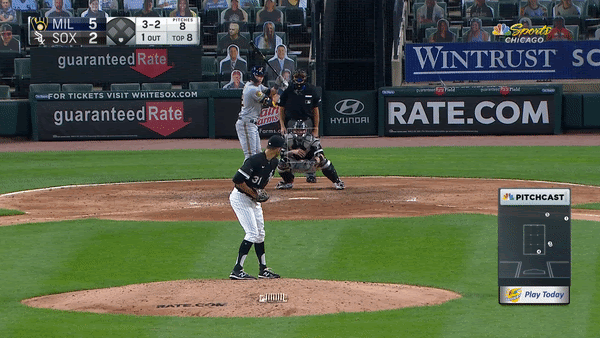
The first is an elevated fastball with two strikes, one of the hardest pitches to lay off in baseball and one that Yelich had been swinging at for the first two weeks.
Then, with a full count, Yelich nearly offers at a really good slider. It starts over the outer edge before dipping back toward Yelich’s back foot. Just two pitches prior, Cishek had thrown a slider for a called strike at the bottom of the zone. This time, though, you can almost see Yelich recognize it’s going to dive off the plate—not by much—and he does so early enough to lay off.
Both were sound takes that Previous Yelich flails at.
After the game, Yelich himself basically came out and said he had been guessing for the better part of his first eight games.

Friday and Saturday weren’t great for Yelich against Trevor Bauer and Anthony DeSclafani—1-for-8 with a homer and three strikeouts—but the process didn’t look as lost as it did early in the year.
Then came Sunday. Two more walks. A triple…
…And this absolute tater off the scoreboard.
It’s also worth noting that Yelich, one of the premier fastball hitters in baseball since he debuted in 2013, is back to punishing heaters that catch too much of the plate. Each of his homers, as well as his triple, were on fastballs.
These are all good signs for the Brewers, who are going to rely heavily on Yelich to produce in an offense that has been highly underwhelming this season.
We’re buying Randy Dobnak’s start.
~Jake
Wait, so is this Randy Dobnak thing real?
Last year, it was just a nice feel-good story of some guy with a funny mustache who threw a few good games and that was going to be the end of things. As the offseason continued, it became clearer that he might get another shot to start, but, for me at least, it didn’t feel like a long-lasting endeavor. A non-prospect who throws in the low-90s isn’t normally the recipe for a starter on a playoff team.
Just three games into this weird season, though, he’s continuing to excel. Somehow.
In three starts, Dobnak is 2-1 with a 0.60 ERA, allowing just one run in his first appearance of the year in which he dueled with former AL Cy Young winner Dallas Keuchel.
His latest battle was a homecoming of sorts, in which he allowed just three hits in six innings of work against the Pittsburgh Pirates, the team he grew up rooting for. He didn’t walk a batter and struck out just one, which is more like a vintage Brad Radke start than a 2020 start.
Sources tell Rich People Conversations that Rick Anderson is trying to convince Tigers GM Al Avila to sell the farm for Dobnak.
So, how is a soft-throwing pitcher posting sub-1.00 ERAs in 2020?
Maybe he’s limiting hard contact? That’s a good way to avoid damage.
Well, not quite. In his career, he’s allowed what FanGraphs calls hard hits 43.3% of the time. Compared to every other starter who has thrown more than 10 innings since the start of the 2019 season, he’s 225th, and in the 32nd percentile according to Baseball Savant. Not great.
OK, so maybe it’s a really strong pitch mix. He could be throwing five or six different pitches with a funky delivery and that’s throwing batters off.
Alas, this is no Johnny Cueto situation. Dobnak throws just four pitches, according to Baseball Savant: a sinker (44.5% of the time this year), a curveball (32.4% this year; for what it’s worth, FanGraphs calls it a slider) a changeup (16.4%) and a four-seamer (6.7%). That’s not exactly an advanced repertoire, especially when you’re huffing a 91.1 mph sinker 44.5% of the time.
The thing is, all of his pitches deliver positive value. Pitch Info values all four of his pitches as above average, which says a lot for someone with limited velocity, unremarkable spin rates and rather forgettable movement on his pitches. The sinker is his only pitch with above-average movement, dropping 30 percent more than your average sinker.
OK, so homie has a really good sinker, that’s how he’s doing it, right?
Um, not quite.
I don’t know if you’ve heard, but sinkers are kinda out of fashion these days and there’s a really detailed, elegant way of explaining it but this is Rich People Conversations, so here’s the short and dirty: batters are focusing more and more on launch angle (literally trying to uppercut the ball more consistently) and this launch angle revolution is death for sinkers. A sinker inherently drops into the swing path and that leads to bombas. So, these days, sinkers aren’t great.
Now, with all of that said, a good sinker can still be an effective pitch. Dobnak hasn’t allowed a homer in his young career yet and has only been tagged for two doubles. That’s not bad! Like all good sinker ballers, Dobnak lives on the edges, throwing 43.8% of his pitches on the Edge, according to Baseball Savant and yields tons of groundballs. His Edge rate isn’t elite, but, like so much of Dobnak’s stats, it’s slightly above average.
A closer look, though, shows that batters have slugged a minuscule .308 but have an expected slugging percentage of .517 against the sinker. That’s like going from Wilmer Difo to Francisco Lindor. So, that probably means some regression is coming.
But wait, we’re still trying to figure out what makes him good! Yes, some very lucky batted ball results from Dobnak’s main pitch is significant. But let’s look at that breaking ball.
He’s thrown just 77 curveballs in 2020, but it’s been a stellar pitch, giving up just one hit. Opponents are slugging just .063 against the curve with a .315 xSLG. Much better!
It isn’t an elite swing-and-miss curveball like the old Barry Zito, but it’s notably better in that category, making batters whiff 32.5% of the time.
The changeup isn’t quite as good, but it’s still a strong pitch that’s yielded only two hits so far this year. It’s a tertiary pitch, but a relatively good one at that.
Hundreds of words later, it’s clear there isn’t one thing that is making Dobnak stand out. It’s a combination of good luck, good placement and limiting weaknesses. There are a lot of pitchers who throw harder and have more, nastier pitches, but Dobnak is able to pair good location with slightly above average pitches across the board. Perhaps that will change if batters finally figure out that sinker. If that happens, Dobnak has already brought more value than anyone could rightly have expected. '
Ben Gamel’s minor adjustment paying major dividends
~Tom
When the Milwaukee Brewers received outfielder Benjamin Gamel in the 2018 Domingo Santana trade, we knew a few things:
Ben is the younger brother of utility man Mat Gamel, who played 106 games for Milwaukee from 2008-12. So that’s cool.
Ben brings a decent left-handed bat to the lineup and is a serviceable corner outfielder who could also play center when needed.
If Broadway is hiring, Ben could be the stunt double of Simba on the live action “Lion King” production. Look at that mane.

At the time of the trade, Gamel had two full MLB seasons under his belt. He was nearly an everyday starter for Seattle in 2017, logging a .275/.322/.413 slash line with 27 doubles and 11 homers in 134 contests. Gamel’s playing time dropped from 550 plate appearances in 2017 to just 293 the following summer, although he logged a career-best 106 OPS+ that season.
And we know Gamel’s 2019 campaign isn’t ever going to be honored in the Brewers Walk of Fame. The outfielder played slightly above-average defense (1.0 fWAR) while often struggling at the plate — career-worst 29.2 K% and 87 wRC+.
With names like Yelich, Lorenzo Cain and Ryan Braun sauntering through the Miller Park outfield, Milwaukee doesn’t need much from Gamel, its fourth outfielder. But the Brewers need something.
After avoiding arbitration and agreeing to a one-year deal with a club option for 2021, Gamel went back to the drawing board this offseason. At age 28, when most players hit the peak of their careers, Gamel completely changed his approach at the plate.
Let’s dig into the receipts.
First off, the stance.

Whoa! As you can see, the outfielder looks completely different at the beginning of his swing. In 2019, Gamel’s hands were near his head, and the barrel of his bat was pointed towards the home dugout. His knees were slightly bent and his shoulder was leaning towards home plate, enough that we could read the number 16 on the back of his jersey. In 2020, though, he looks completely different. Gamel’s knees are straight, hands are above the plate and his bat is pointed towards the heavens. The only consistency between the two photos is Gamel’s luscious mane.
If you think Gamel’s new batting stance looks familiar, it probably is because, well, we’ve seen it produce at an MVP level for nearly two seasons.

That’s right. It’s like Gamel was running late for spring training and asked to copy Yelich’s homework before camp. Luckily for Gamel, the Brewers will appreciate it if he plagiarizes Yelich’s production on the field.
Gamel’s hand placement at the start of his swing is key. As you can see (and definitely watched last season), he’d consistently be terribly behind pitches. Like this strikeout, courtesy of Philadelphia right-hander Juan Nicasio.

Notice the path of Gamel’s hands. They start behind the head, drift towards home plate, then are slung back towards the catcher as Gamel (unsuccessfully) loads up to mash an absolute tank. *whiff*
Fast forward to an at-bat this season against the feared (el oh el) Joe Musgrove. Look at Gamel’s hands now! They stay in basically the same place until his barrel is ready to enter the zone. There is no wasted movement. And, POW! a cardboard cutout goes home with a souvenir (or a terrible dent).

It’s a very, very small sample size (as we’ll be saying throughout the 2020 season), but it looks like Gamel’s newfound approach is working.
In 10 games (nine starts), Gamel has registered a .222/.263/.500 slash line. Ok, that’s not great. Or good, even. But he’s notched at least one hit in seven of nine starts. According to FanGraphs, Gamel is hitting the ball hard 54.5% of the time, which is more than double his 2018 output and 17% more often than last season. For the first time in his career, Gamel is hitting fewer ground balls (27.3%) than fly balls (31.8%) or line drives (40.9%). His isolated power (slugging percentage minus batting average) has increased from a mere .125 last year to .278 early on in 2020.
Look, Gamel isn’t ever going to win MVP like his batting stance influencer. However, now that Lorenzo Cain has opted out of the season, Milwaukee needs Gamel now more than ever. It’s the biggest opportunity of his career.
Hopefully, the new-look stance is up to the challenge. He looks the part so far.
Here, watch some filth.
~Curt
No matter how good or bad the baseball played by the Brewers or Twins is, there will always be some nasty pitches that come from it. I say this with confidence, because I just watched some really bad baseball from both teams but still managed to fall head over heels over, like, 13 different Corbin Burnes pitches.
For the second straight week (of many, hopefully), I present to you the filthiest filth I saw this week from Brewers and Twins hurlers.
Let’s kick things off with Jorge Alcala, whom I had never heard of this week until I saw him chuck this slider at 92 mph (!!!) to get Old Friend Brett Phillips.

Tyler Duffey is probably one of the more underrated arms in baseball. Sometimes I feel like I’m staring into Corbin Burnes’ future when I watch him pitch.

Jake wrote plenty about why Randy Dobnak has succeeded despite an unorthodox profile already, so here’s a GIF that helps summarize why. Hello, armside run, my beautiful friend.

I love a good changeup. It may be my favorite pitch to watch hitters flail at, although sharp sliders are right up there. I slowed down this Kenta Maeda change to Josh Bell because, well, I could and it’s gorgeous.

You didn’t think we would get through this without some Corbin Burnes 98 WITH SINK RIGHT ON THE BLACK, did you?

And, also, more Corbin Burnes, who Is Good Now.
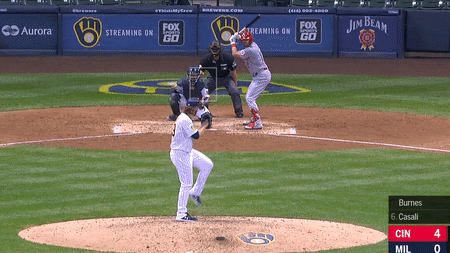
I now present to you my favorite pitch of the week, coming from the right arm of Josh Lindblom. Don’t let the kids see this kind of content. Seriously.
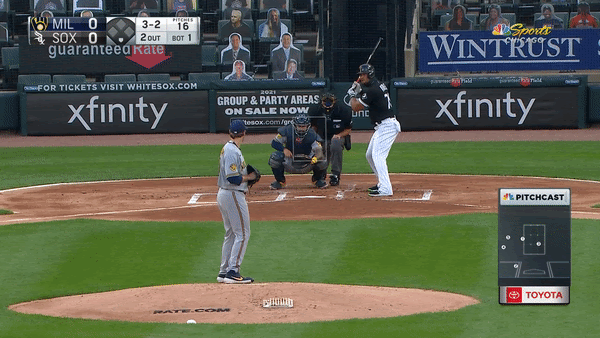
We had Leury Garcia getting got by a nasty curve in last week’s section of “Here, watch some filth” and, would you look at that, it’s time for round two.

Freddy Peralta displayed some pure ordure in his three-inning outing on Thursday, which furthers the narrative that Relief Fred is the best Fred.

Aaaand to close, we have Josh Hader, who doesn’t pitch much nowadays, but when called upon has been dominant. (We wrote in February about how Hader had an underutilized weapon in his slider and hooooo boy has he started letting that pitch loose. This is a victory lap.)
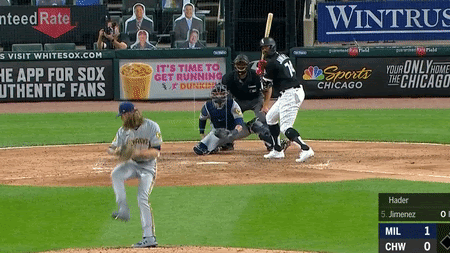
An unexpected love affair
~Jake
(Curt’s note: Jake wrote this almost two full weeks ago and I, the dingus that usually copies and pastes everything into Substack, forgot to include it in the edition it was supposed to run in. So, here it is, two weeks later. Sorry Jake!)
Let me tell you about the time I fell in love.
It was a rather humdrum Monday, neither hot nor cold outside, not a long day nor a short day. It was just a day.
And then it entered my life.
In the middle of a dark Pittsburgh night, it arrived with a flourish unseen since Michelangelo.
In seconds, it captured my heart.

I couldn’t, nay I can’t, believe my eyes. I’ve seen hundreds, thousands, maybe hundreds of thousands of changeups since Johan Santana, but none like this. Even Santana’s, a string-pulling pitch if ever there was one, never had the malevolence like that of Devin Williams’ changeup.
It left Jarrod Dyson, a veteran who has struck out to many a changeup, wondering if he had seen God. Or something.

The pitch rockets out of his hand no different than his high-90s fastball, but it dives away like a masked person runs away from a hug. It does so with an enviable gusto and pure vengeance in its heart.
But in my heart, dear reader, there was nothing but love.
I needed to see it again, but MLB app, the damn MLB app, wouldn’t rewind.
Within minutes, though, it returned. This time to an unsuspecting Kevin Newman.

It returned not once, but twice, with more confidence and obvious love for the attention. This changeup yearned for the attention normally reserved for curveballs and sliders.
Newman, the victim to its siren-like charm, could do nothing but stare.

I needed to know more about this new love of mine. To Baseball Savant I went, and as always, the heart grew fonder.
A spin rate around 2900 RPM! A low-to-mid-80s velocity! Movement!
On this night, Williams, an intriguing relief prospect, threw eight Eros-summoning changeups.
Alas, like most love stories, however, this one ended in heartbreak.
The changeup, beautifully delivered for a lucky strike call, disappeared. In its place, a 97 mph fastball up in the zone against Colin Moran. The Pirate slugger (I guess?) turned on this lesser pitch, and launched it 438 feet away into the Allegheny River. A 1-1 game turned into a 2-1 game. Thus, the magic died.
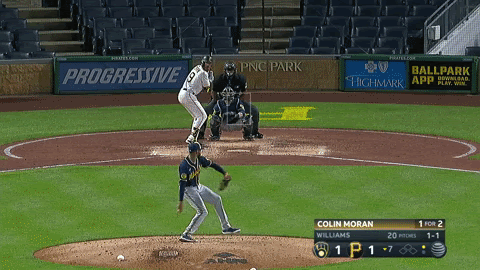
Perhaps a love so strong was never bound to last.






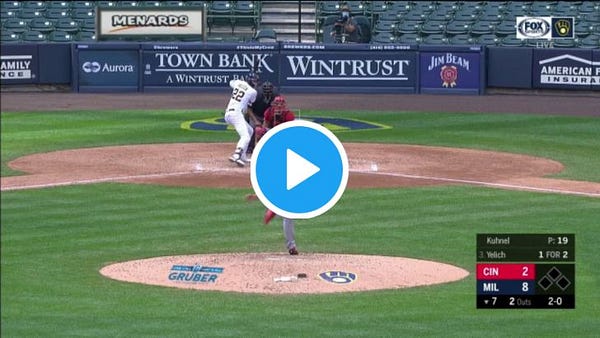
awesome blog! love to read it, humor is king! hope you're well, fam